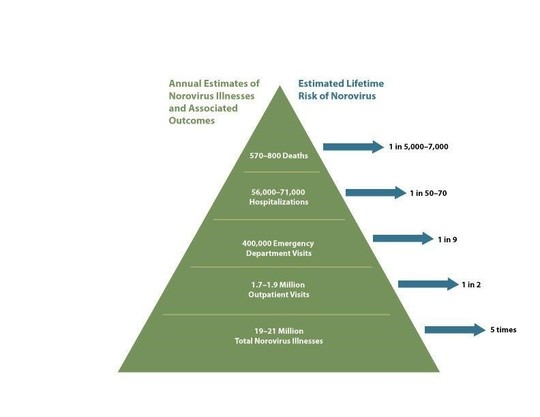Report norovirus and shiga toxin-producing E. coli (STEC)
Because of advances in diagnostic testing, it makes sense to expand the list of reportable illnesses by adding some of the most common foodborne illness pathogens:
-
Norovirus is the leading cause of vomiting and diarrhea in the United States. MDH sends stool kits to ill persons during suspected norovirus outbreak investigations.
- Several types of shiga toxin-producing E. coli (STEC) can now be detected. Infections caused by other types of STEC can cause severe illness comparable to E. coli O157:H7.
Stopping norovirus outbreaks can save lives
Norovirus is the most common cause of foodborne outbreaks in Minnesota, causing 57% of foodborne outbreaks. The CDC estimates that there are 5,461,731 cases of norovirus illness, 540,711 doctor visits, 14,663 hospitalizations, and 149 deaths due to norovirus each year in the U.S.
 Figure: Burden of Norovirus in the United States. Estimates of the annual number of illnesses and associated outcomes for norovirus disease in the U.S., across all age groups. Lifetime risks of disease are based on a life expectancy of 79 years of age.
Ill employees report additional information to PIC
In order to help reduce the risk of illness transmission, employees must now provide necessary additional information to the PIC. This includes:
- Date of onset of symptoms
- Diagnosis without symptoms
- Specific symptoms
In addition, employees need to report if they have been exposed to, or are the suspected source of a probable or confirmed disease outbreak within the last 30 days.
Revise your employee illness policy
If your establishment has an employee illness policy that meets current Minnesota food code, you may need to update it in order to meet each of the new requirements effective January 1, 2019.
- Add norovirus to the list of reportable illnesses and replace E. coli O157 with shiga toxin-producing E. coli.
- Make sure your policy excludes employees with vomiting and/or diarrhea for at least 24 hours after symptoms end. This common practice is now a requirement.
- Add work restrictions for employees who have sores on their hands or arms if those sores have pus and cannot be covered up.
This is a good time to review the entire employee illness policy to ensure it addresses all the requirements in Minnesota food code as well as any local ordinances. Contact your inspector for more information. The Local Book has contact information for all MDH and local agency inspectors.
|